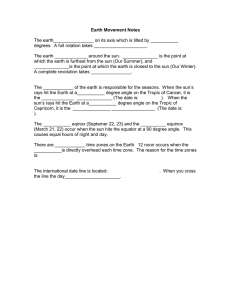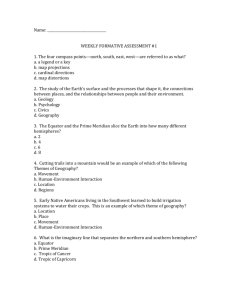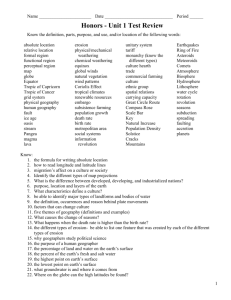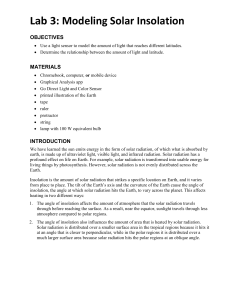Practice Exercises Chapter 16 PSC1515 a.____________________________
advertisement
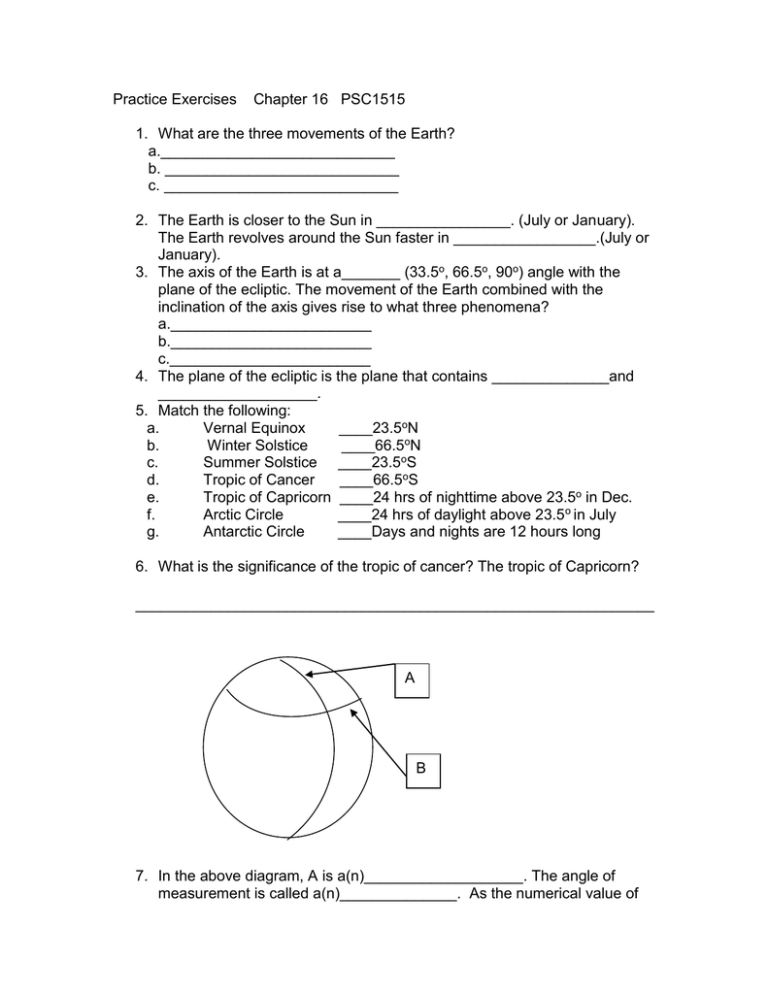
Practice Exercises Chapter 16 PSC1515 1. What are the three movements of the Earth? a.____________________________ b. ____________________________ c. ____________________________ 2. The Earth is closer to the Sun in ________________. (July or January). The Earth revolves around the Sun faster in _________________.(July or January). 3. The axis of the Earth is at a_______ (33.5o, 66.5o, 90o) angle with the plane of the ecliptic. The movement of the Earth combined with the inclination of the axis gives rise to what three phenomena? a.________________________ b.________________________ c.________________________ 4. The plane of the ecliptic is the plane that contains ______________and ___________________. 5. Match the following: a. Vernal Equinox ____23.5oN b. Winter Solstice ____66.5oN c. Summer Solstice ____23.5oS d. Tropic of Cancer ____66.5oS e. Tropic of Capricorn ____24 hrs of nighttime above 23.5o in Dec. f. Arctic Circle ____24 hrs of daylight above 23.5 o in July g. Antarctic Circle ____Days and nights are 12 hours long 6. What is the significance of the tropic of cancer? The tropic of Capricorn? ______________________________________________________________ A B 7. In the above diagram, A is a(n)___________________. The angle of measurement is called a(n)______________. As the numerical value of the angle increases the distance from the _______________becomes larger. This location is in _______________________. 8. In the above diagram, B is a(n)__________________. The angle of measurement is called a(n)_________________. As the numerical value of the angle increases the distance from the ________________becomes larger. 9. The Sun rises in the _____________and sets in the _____________. As you travel to the west from where you are the time of day becomes ___________________(earlier or later). As you travel to the east from where you are the time of day becomes _________________(earlier or later.) 10. The boundary that divides one day from another day is called the________________________________. It is located in the __________________. 11. A lunar eclipse only occurs during what phase of the moon?_______________ 12. If the Moon is between the Sun and the Earth it is possible to have a ______________(solar or lunar) eclipse. 13. If the Earth is between the Moon and the Sun it is possible to have a ____________________(solar or lunar) eclipse. Answers: 1. revolution around the Sun, rotation around the axis, wobbling. 2. January, January 3. 66.5o Changing seasons, climates, lengths of days and nights. 4. Earth and the Sun 5. d, f, e, g, b, c, a. 6. The limits towards the poles within which the Sun appears directly overhead during the course of the year. 7 meridian, longitude. Prime meridian Greenwich, England. 8. . parallel, latitude. Equator. 9. east, west. Earlier, later. 10. international date line, in the Pacific Ocean. 11. Full 12. Solar 13. Lunar
